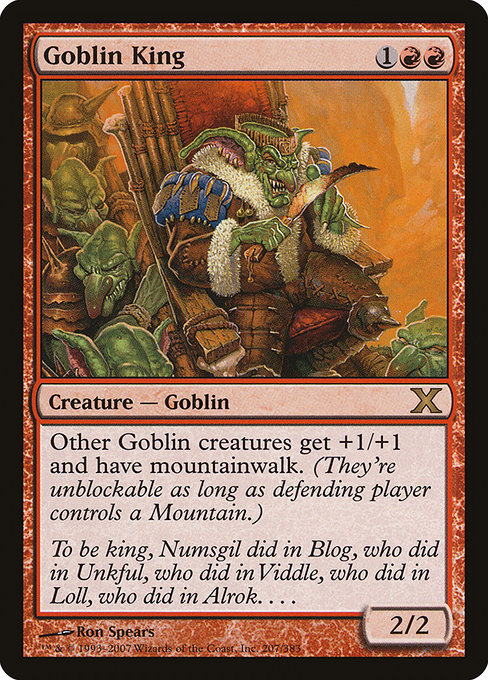
Image courtesy of Scryfall.com
Goblin Royalty and the Hilltop Horde: A Look at Goblin Culture
If you’ve ever leaned into a red mana rampage that smells like sulfur and victory snacks, you’ve felt the heartbeat of goblin culture—loud, unfiltered, and fiercely communal. Goblin King, a rare from Tenth Edition, is more than a stat line and a clever keyword; it’s a cultural mirror held up to the goblin race. With its {1}{R}{R} mana cost, the card yells “we swarm, we celebrate, and yes, we rule—at least until the next trick.” 🧙🔥💎⚔️
On the battlefield, Goblin King serves as a catalyst for goblin kinship. Its text—“Other Goblins get +1/+1 and have mountainwalk”—is a compact manifesto: leadership that elevates the entire tribe, and terrain as a shared weapon. The goblins aren’t chasing singular glory; they’re amplifying the chorus of their pack. In many ways, this reflects a plane-wide goblin culture that prizes numbers, improvisation, and the brutal efficiency of a well-coordinated mob. The king isn’t just a ruler; he’s a rallying point, a loudspeaker that makes every goblin feel like the centerpiece of the raid. 🎲
“To be king, Numsgil did in Blog, who did in Unkful, who did in Viddle, who did in Loll, who did in Alrok. . . .”
The flavor text reads like a rough-stitched epic of succession, a goblin soap opera where leadership is handed down through a chain of chaotic conquests rather than a formal ceremony. This is not a planet-wide monarchy with ceremonial robes; it’s a tribal tradition built on audacity, revenge, and the capacity to outwit the next goblin who dares to claim the throne. In that sense, Goblin King embodies a cultural arc: leadership is earned through impact, and the entire tribe thrives when one ambitious goblin lights the fuse. The plane itself—rugged and punctuated by crags and peaks—feels tailor-made for goblins who prefer the road, the mountain pass, and the flash of a well-timed maneuver. 🧭⚡
Culture mirrored in gameplay: how the card shapes a goblin strategy
From a gameplay perspective, Goblin King is a textbook example of red’s favorite trick: the swarm that is more than the sum of its parts. By pumping all goblins, the card delivers a social buff—a signal that the tribe’s strength comes from collective momentum rather than individual brute force. The mountainwalk ability, granted to “Other Goblins,” adds a tactical layer: your goblin horde can slip through defenders who rely on basic terrain blocking, turning mountains from simple geography into a strategic advantage. In tournaments and casual games alike, that movement option often makes the difference between a narrow win and a spectacular swing. ⚔️
Smart goblin players lean into a few practical ideas when Cobbling together a Goblin King-focused shell:
- Tribal unity over lone rangers: prioritizing goblins that benefit from the King’s global buff creates a steady, resilient board presence.
- Terrain as a weapon: Mountainwalk isn’t just flavor—it’s a gateway to circumvent blockers and force tempo swings, especially when paired with other red tricks that reward aggressive play.
- Tempo and reach: the early game wants cheap threats that capitalize on the King’s buff later, turning each attack into a potential alpha strike.
- Board-wipe considerations: red goblin decks must balance aggression with board-preservation, since a swept board can erase your momentum in an instant.
Design-wise, Goblin King demonstrates a deliberate elegance: a three-mana investment that pays off in a tribe-wide buff and a thematic link to volcanic, rugged planes. The art by Ron Spears channels that same energy—gaudy crowns, expressive chaos, and a hint of gleeful mischief—perfectly matching red’s reckless charm. The Tenth Edition core-set era often favored clean, direct lines of play, and Goblin King sits squarely in that tradition: instantly graspable, yet capable of surprising depth when woven into a broader goblin synergy. 🎨
“Other Goblins get +1/+1 and have mountainwalk.” The simplicity of the text belies the layered culture behind it: leadership as a shared tool, not a solitary crown. This is goblin social engineering in a single line. 🧙🔥
Collectors and nostalgia-minded players often circle Goblin King for its role in early tribal archetypes and its status as a rare reprint in a core-set era that emphasized accessibility. The card’s value—illustrated by pricing that sits around the mid-teens in USD—speaks to both its enduring playability and its fond place in MTG history. The red goblin story, amplified by this token of leadership, continues to echo in modern decks that celebrate fast starts, synergy, and the joyous chaos that goblins bring to the table. 💎
Beyond the table, Goblin King invites fans to reflect on how a culture can be defined by its leaders and its terrain. The king isn’t a distant figure of authority—he is a symbol of a tribe that thrives on collective momentum and the thrill of scoring a decisive blow when the mountain paths clear for ambush. In the grand tapestry of MTG lore, goblins remind us that sometimes the most memorable civilizations are forged not by grand monuments, but by the raucous chorus of a hundred tiny voices shouting in unison. 🎲
For players who relish the aesthetic of rugged, high-energy goblin culture, this card also hints at a broader conversation about plane design, creature tribes, and how a single buff can reshape your approach to the game. If you’ve ever wanted to push a goblin swarm from handful of threats into a roaring parade, Goblin King is a gateway card—a reminder that leadership, like mana, is a scarce resource best used with friends in tow.